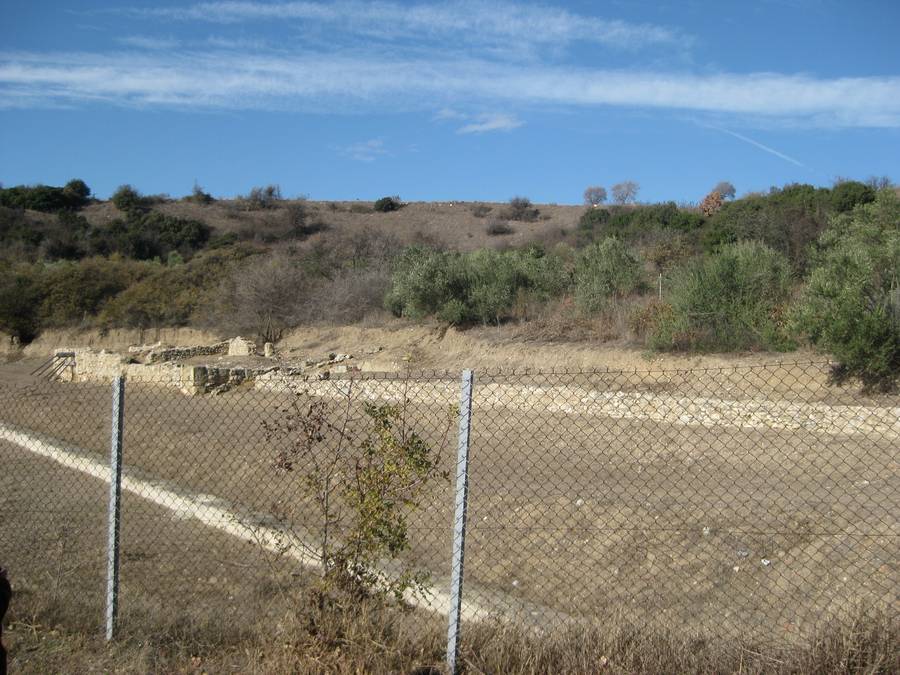
The ancient theater of Amphipolis, as yet unexcavated, lies northeast of the ancient Gymnasium, within the long walls of ancient Amphipolis and towards their eastern section.
Amphipolis was established in 437 BC by Athenian colonists, with Hagnon as its founder, on the site of the earlier settlement of “Ennea Hodoi” (“Nine Roads”). Its exceptional strategic and economic importance determined and formed the history of the city, from its foundation to the final years of the Byzantine state, as it is sketched by written sources and excavation finds. Amphipolis was a bone of contention between Athenians and Spartans during the Peloponnesian War, the target of Philip II of Macedon, the naval base of Alexander the Great for his conquest of Asia and a place of exile for his wife Roxana and his young son following his death, the capital of the Roman province of Macedonia Prima, part of the ancient Egnatian Way, an episcopal seat in Christian times, and a fortified town after the 14th century AD.
One of the most important building complexes to have come to light, with a lifetime stretching perhaps from the end of the Classical period to early Roman times, is the ancient Gymnasium, immediately adjoining and connected to the ancient theater of Amphipolis. A large stone drainage duct, revealed during the excavation of the Gymnasium, runs from the theater area across the Gymnasium.
A first test trench was excavated by D. Lazaridis thirty years ago on the site of the theater “orchestra”, to a depth of several metres (7-8 m), in the area now covered by an olive grove, next to the ancient Gymnasium. The cavea has not survived, but its layout is clearly visible because the cavea seats were used as building material by the inhabitants of Amphipolis and the surrounding area from the 1920s onwards. The locals called the area “Skalakia” (“Little Stairs”) due to the cavea, and the local landowner sold off the stones for use as building material. The orchestra and some of the front rows of seats of the cavea are thought to survive deep down, and their excavation could contribute to a satisfactory portrayal of the ancient theater. The theater itself is set in a prominent amphitheatrical position, with a view of the mouth of the River Strymon and the surrounding mountains.
Katerina Peristeri
Archaeologist
Ancient Theatre of Amphipolis
Theatre
Τhe ancient theatre of Amphipolis (Phyllida Province, Amphipolis Municipality, Serres Prefecture), which unfortunately remains unexcavated, lies northeast of the ancient Gymnasium, within the long walls of ancient Amphipolis and towards their eastern section, in a prominent amphitheatrical position, with a view of the mouth of the River Strymon and the surrounding mountains. It lies within the wider archaeological site of Amphipolis, the most important in Serres Prefecture. A first test trench was excavated by D. Lazaridis thirty years ago on the site of the theatre “orchestra”, to a depth of several metres (7-8 m), in the area now covered by an olive grove, next to the ancient Gymnasium.
No excavated parts of the theatre are visible.
Κ. Λαζαρίδη, Το Γυμνάσιο της Αμφίπολης, ΑΕΜΘ 3, 1989, p. 50 Δ. Λαζαρίδης, ΠΑΕ 1965, p. 48, para. 6.
The ancient theatre of Amphipolis, as yet unexcavated, lies northeast of the ancient Gymnasium, within the long walls of ancient Amphipolis and towards their eastern section. The locals called the area “Skalakia” (“Little Stairs”) due to the cavea.
Unfortunately any attempt at dating is uncertain due to lack of data. The theatre may be connected to the complex of the ancient Gymnasium, which it adjoins.
The ancient theatre of Amphipolis, as yet unexcavated, lies northeast of the ancient Gymnasium, within the long walls of ancient Amphipolis and towards their eastern section. Amphipolis was established in 437 BC by Athenian colonists, with Hagnon as its founder, on the site of the earlier settlement of “Ennea Hodoi” (“Nine Roads”). Its exceptional strategic and economic importance determined and formed the history of the city, from its foundation to the final years of the Byzantine state, as it is sketched by written sources and excavation finds. One of the most important building complexes to have come to light, with a lifetime stretching perhaps from the end of the Classical period to early Roman times, is the ancient Gymnasium, immediately adjoining and connected to the ancient theatre of Amphipolis: a large stone drainage duct, revealed during the excavation of the Gymnasium, runs from the theatre area across the Gymnasium. The orchestra and some of the front rows of seats of the cavea are thought to survive deep down, and their excavation could contribute to a satisfactory portrayal of the ancient theatre.
The site of the theatre is now covered by an olive grove. The cavea has not survived, but its layout is clearly visible because the cavea seats were used as building material by the inhabitants of Amphipolis and the surrounding area from the 1920s onwards.
A first test trench was excavated by D. Lazaridis thirty years ago on the site of the theatre “orchestra”, to a depth of several metres (7-8 m), in the area now covered by an olive grove, next to the ancient Gymnasium.
–
40.821011°
23.847928°
| Name | Date | Amount (€) |
|---|---|---|
| Diazoma Association | 200.00 | |
| Diazoma Association | 6.000.00 | |
| Despena Tychonidou | 10.00 |
| Description | Budget | Target | Remarks |
|---|---|---|---|
| Expropriation of landed property | 0.00 | 0.00 |
Last update, April 2020